Saturday, 7 April 2012
Wednesday, 21 March 2012
RM - Genre Reseach: Slasher
The slasher genre is a sub-genre of the horror genre, it
normally involves a psychopathic killer stalking and killing a sequence of
victims in a violent manner. The tool often used for during these films is a
knife or axe.
The first film which could be described as a Slasher film is
called Thirteen Women (George Archainbaud, 1932) however the genre become
popular with the releases of Peeping Tom (Michael Powell, 1960) and Psycho (Alfred Hitchcock, 1960) both of these films were controversial when first released,
despite the latter film only having two killings in the film. The reason for
this is that the film features the "whodunit" plot structure, knife
wielding and mentally disturbed killer, twist ending and 'stalking' camera
aspect. However since release the shower scene has become a classic scene from
the horror genre as well as Psycho now being called "the mother of all slasher films".
Following the success of Psycho, director Francis Ford Coppola rushed into production for Dementia 13 or as its better known in the UK "The Haunted and the Hunted". The film was released in 1963.
However it was not until the 1970s until it is considered the first proper slasher film was released. This was Black Christmas (Bob Clark, 1974). The reason for this is that Black Christmas was noted as one of the earliest films to include conventions associated with the genre. These conventions included: a mysterious stalker, a set of adolescent or young adult victims, a secluded location with little or no adult supervision, point-of-view camera shots representing the killer's perspective and graphic depictions of violence and murder. Despite this there are other firms which are also noted for helping the genre establish itself, these films were: Savage Weekend (David Paulsen, 1979), Scream Bloody Murder (Robert J. Emery, 1972), Silent Night, Bloody Night (Charles E. Sellier Jr., 1984), The Toolbox Murders (Dennis Donnelly, 1978), Drive-In Massacre (Stu Segall, 1977), The Driller Killer (Abel Ferrara, 1979), and The Texas Chain Saw Massacre (Tobe Hooper, 1974).
Although it was not until 1978 were a slasher film received huge box office success, the film was Halloween (John Carpenter, 1978) and then in 1980 with Sean S. Cunningham's Friday the 13th. Both of these films have produced numerous sequels and remakes. These two films were gained the genre huge popularity.
In the following years whilst the slasher genre was in its prime, the three films Black Christmas, Halloween and Friday the 13th, were inspirational with many films with the time of the being associated with special days or holidays. Also films used Friday the 13th's idea of having youth camps in wooded areas, although it was not until A Nightmare on Elm Street (Wes Craven, 1984) and Child's Play (Tom Holland, 1988) until the format changes with supernatural aspects now being included. However the genre has now come into decline and the majority of the genre's film now goes out straight to DVD with the exception of a sequel or a re-make of one of the films which introduced and established conventions in the genre.
However it was not until the 1970s until it is considered the first proper slasher film was released. This was Black Christmas (Bob Clark, 1974). The reason for this is that Black Christmas was noted as one of the earliest films to include conventions associated with the genre. These conventions included: a mysterious stalker, a set of adolescent or young adult victims, a secluded location with little or no adult supervision, point-of-view camera shots representing the killer's perspective and graphic depictions of violence and murder. Despite this there are other firms which are also noted for helping the genre establish itself, these films were: Savage Weekend (David Paulsen, 1979), Scream Bloody Murder (Robert J. Emery, 1972), Silent Night, Bloody Night (Charles E. Sellier Jr., 1984), The Toolbox Murders (Dennis Donnelly, 1978), Drive-In Massacre (Stu Segall, 1977), The Driller Killer (Abel Ferrara, 1979), and The Texas Chain Saw Massacre (Tobe Hooper, 1974).
Although it was not until 1978 were a slasher film received huge box office success, the film was Halloween (John Carpenter, 1978) and then in 1980 with Sean S. Cunningham's Friday the 13th. Both of these films have produced numerous sequels and remakes. These two films were gained the genre huge popularity.
In the following years whilst the slasher genre was in its prime, the three films Black Christmas, Halloween and Friday the 13th, were inspirational with many films with the time of the being associated with special days or holidays. Also films used Friday the 13th's idea of having youth camps in wooded areas, although it was not until A Nightmare on Elm Street (Wes Craven, 1984) and Child's Play (Tom Holland, 1988) until the format changes with supernatural aspects now being included. However the genre has now come into decline and the majority of the genre's film now goes out straight to DVD with the exception of a sequel or a re-make of one of the films which introduced and established conventions in the genre.
Sourced:
Wikipedia - http://en.wikipedia.org/wiki/Slasher_film
IMDB - http://www.imdb.com/
RM - Target Audience
[Draft]
As the film we are producing will be part of the slasher genre
and has taken inspiration from several well known films in that specific genre,
including Eden Lake (James Watkins, 2008), The Thing (John Carpenter, 1982), An American Werewolf In London (John Landis, 1981) and The Lost Boys (Joel Schumacher, 1987). Our primary audience
would be 15 – 24. However there would also be a secondary audience of slasher
and horror genre fans and fans of the movies listed above.
Therefore our aim is to make this movie an 18 rated film
certified by the BBFC. Although at the moment we are unsure of implementing the
stabbing scene, which we have done in a sample scene and feel it can be
produced at a higher quality next time, several of the cast members will appear
to be taking drugs and drinking.
All - Finalised Idea
The film starts off with establishing shots of moorland and the surrounding area – similar to sample scene 2 - with the last establishing shot containing a group of friends who are exploring the moor.
The group of friends, who are aged around 18 will be messing around, i.e. drinking and/or taking drugs, and having laughs with each other.
Whilst on the moor the pass an adult, whilst passing an adult a member from the group of friends does an action to annoy him/her – the adult could warn the friends about entering a wood nearby of the group of friends start mocking the adult.
Whilst in the woods one of the group of friends becomes occupied, i.e. having to tie his/her shoelace and when he/she looks up they have gone, as the friends think it’s a joke. The person starts shouting to try and attract his/her friend’s attention but has no luck. The person then tries to re-trace his/her steps and is met by a hooded figure, who will be the adult the group of friends passed earlier.
The person starts asking the hooded figure questions on the whereabouts of his friends but the figure just walks towards him/her with no response. In fear the person runs and is chased by the hooded figure – similar scenario in what we did in sample scene 1.
Sample scene 1:
Sample scene 2:
The group of friends, who are aged around 18 will be messing around, i.e. drinking and/or taking drugs, and having laughs with each other.
Whilst on the moor the pass an adult, whilst passing an adult a member from the group of friends does an action to annoy him/her – the adult could warn the friends about entering a wood nearby of the group of friends start mocking the adult.
Whilst in the woods one of the group of friends becomes occupied, i.e. having to tie his/her shoelace and when he/she looks up they have gone, as the friends think it’s a joke. The person starts shouting to try and attract his/her friend’s attention but has no luck. The person then tries to re-trace his/her steps and is met by a hooded figure, who will be the adult the group of friends passed earlier.
The person starts asking the hooded figure questions on the whereabouts of his friends but the figure just walks towards him/her with no response. In fear the person runs and is chased by the hooded figure – similar scenario in what we did in sample scene 1.
Sample scene 1:
Sample scene 2:
Monday, 19 March 2012
RM/SB - Sample Scene 2
 |
| Cow and Calf, a local landmark, which could be used as an establishing shot |
Here is our second sample scene:
RM/SB - Sample Scene 1
Yesterday Sam and I went to a local wood to film a sample scene of the death
aspect. However one of our cast members had to leave before we could finish the
shoot so the last shot is of Sam. Another aspect is that the wood used in this
sample scene is not the final location we intend to uses for the final cut, the
location that we did use was picked due to time issues, however we will resolve
this in the future by better and clearer planning.
Here is the first Sample Scene:
Sunday, 18 March 2012
RM/SB - Sample Scene and Location Scouting
Today (Sunday 18th March) Sam and I visited several locations on Ilkley Moor. This enabled us to gain further ideas on the locations and well as several establishing shots which could be used for the opening scene. Whilst on the Moor we took several photographs enabling us to produce a vodcast on location scouting in the near future. An example of one of the establishing shots is pictured to the right.
We also managed to get two of our friends Peter and Kyle to portray roles for the sample death scene, where Pete portrays the killer and Kyle the victim. However the location we used will be different as we were limited for time for this aspect, although we do know of the woods we would like to film in. A similar style of shots could be included in later rough cuts and the final cut depending on feedback received.
As we filmed two aspects of the opening we intend to create two sample scenes. One of the introduction which only features establishing shots, this is likely where the opening credits would feature, and the second sample scene being part of the death scene which features a chase.
We also managed to get two of our friends Peter and Kyle to portray roles for the sample death scene, where Pete portrays the killer and Kyle the victim. However the location we used will be different as we were limited for time for this aspect, although we do know of the woods we would like to film in. A similar style of shots could be included in later rough cuts and the final cut depending on feedback received.
As we filmed two aspects of the opening we intend to create two sample scenes. One of the introduction which only features establishing shots, this is likely where the opening credits would feature, and the second sample scene being part of the death scene which features a chase.
Saturday, 17 March 2012
RM - Filming
Tomorrow (18th March) both Sam and myself are planning to film footage for a
sample scene, we intend to film several establishing shots which will make part
of the opening scene. We got inspiration for this from the film "An
American Werewolf in London" and "The Thing" however we will be putting our own twist on
it. We will film well known landmarks which anchor the location the film is set
on. However a possibility would be to film a sign anchoring the name of the
town to ensure the preferred reading. We also intend to film part of the death
scene which is likely to take place in a local woods.
RM - Lost Boys: The Tribe Deconstruction
| DVD Cover |
Director: P.J. Pesce
Release Date: 2008
Budget: $4,200,000
Takings: N/A (Straight to DVD)
Warner Brothers
Warner Premiere
 Similarly to “The Lost Boys” the music starts straight away,
causing tension right from the start. The first shot is an establishing shot
which pans around what appears to be a cliff face with sea to the right. There
is a non-diegetic bell which could signify something is going to happen at sea,
something which is done is horror films an example being from JAWS. White text appears on screen as the camera
pans around the cliff face to reveal a seaside town.
Similarly to “The Lost Boys” the music starts straight away,
causing tension right from the start. The first shot is an establishing shot
which pans around what appears to be a cliff face with sea to the right. There
is a non-diegetic bell which could signify something is going to happen at sea,
something which is done is horror films an example being from JAWS. White text appears on screen as the camera
pans around the cliff face to reveal a seaside town. 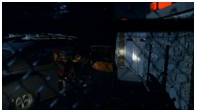 The music is still being
played but voices have overlaid it. This over layering in sound takes the
audience to the next shot as there is a cross fades between the establishing
shot to where the audience sees the first sighting oh people. The eerie music
is still being played, similarly to the first one the audience is focusing on
four boys which one of them is holding a camera which suggests that found
footage might be included in the film which is an aspect used in films with an
example being cloverfield where the entire film was based upon found footage.
White titles are still being displayed anchoring the production teams.
The music is still being
played but voices have overlaid it. This over layering in sound takes the
audience to the next shot as there is a cross fades between the establishing
shot to where the audience sees the first sighting oh people. The eerie music
is still being played, similarly to the first one the audience is focusing on
four boys which one of them is holding a camera which suggests that found
footage might be included in the film which is an aspect used in films with an
example being cloverfield where the entire film was based upon found footage.
White titles are still being displayed anchoring the production teams.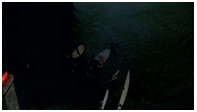 The group of friends are breaking in and generally messing
around and having a laugh with each other, something which we intend to do
(excluding the breaking in aspect). 1:14 into the film and only two shots have
been used. Several cross dissolves and jump cuts are used to signify time has
passed.
The group of friends are breaking in and generally messing
around and having a laugh with each other, something which we intend to do
(excluding the breaking in aspect). 1:14 into the film and only two shots have
been used. Several cross dissolves and jump cuts are used to signify time has
passed. 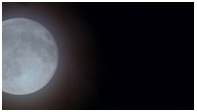 At 1:35 there is a shot of the moon, briefly, thus adds to the tension
as it appears to be a full moon, also the eerie music is still being played
which builds the tension to a further extent.
At 1:35 there is a shot of the moon, briefly, thus adds to the tension
as it appears to be a full moon, also the eerie music is still being played
which builds the tension to a further extent. 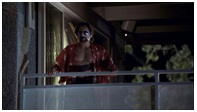
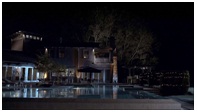 Again the use of cross dissolves
is used to signify time has passed, however the music has now stopped. But has
been replaced by a male who is now watching the boys mess around, this has been
created by the shot establishing where the person is located, match on action
is used here, as the male steps out onto the balcony as the shot changes from
an establishing shot to a long medium shot, which gets closer until the shot is
a extreme close-up of his sunglasses with the boys being reflected in the lenses,
two in each lens. Which is followed by a close-up and music starts again, with
the drumbeat resembling a heartbeat.
Again the use of cross dissolves
is used to signify time has passed, however the music has now stopped. But has
been replaced by a male who is now watching the boys mess around, this has been
created by the shot establishing where the person is located, match on action
is used here, as the male steps out onto the balcony as the shot changes from
an establishing shot to a long medium shot, which gets closer until the shot is
a extreme close-up of his sunglasses with the boys being reflected in the lenses,
two in each lens. Which is followed by a close-up and music starts again, with
the drumbeat resembling a heartbeat. 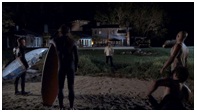
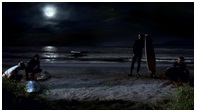 Another jump cut is used to anchor time has passed. The
focus is now on the boys relaxing on the beach and just talking. The shot being
a group shot extreme long shot, there is further anchored the moon is actually
a full moon which could signify something is going to happen on the night. The
shot changes, with the focus also changing, to the older male who was
previously watching the boys. He now is confronting them face to face. The shot
zooms out from a one shot to allow the four boys into the shot. The teenagers
or young adults or being stereotypical in not respecting their elders and
threatening the older male, this is common in this genre with an example being
Eden Lake. During the confrontation mid-shots and close-ups are generally used,
there aren’t any two, three or group shots unless all of the characters are in
shot.
Another jump cut is used to anchor time has passed. The
focus is now on the boys relaxing on the beach and just talking. The shot being
a group shot extreme long shot, there is further anchored the moon is actually
a full moon which could signify something is going to happen on the night. The
shot changes, with the focus also changing, to the older male who was
previously watching the boys. He now is confronting them face to face. The shot
zooms out from a one shot to allow the four boys into the shot. The teenagers
or young adults or being stereotypical in not respecting their elders and
threatening the older male, this is common in this genre with an example being
Eden Lake. During the confrontation mid-shots and close-ups are generally used,
there aren’t any two, three or group shots unless all of the characters are in
shot.
Throughout the confrontation the music is building up which
adds to the tension, tension is also being increased through the lines and the
close-ups of the five characters in the scene. Pictured above and below.
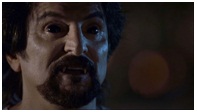 One of them tries to leave,
going past the adult he gets pushed to the floor, the music increases as do the
shots. During the talking between the three boys and the older male, the males
voice gets deeper and his eyes goes fully black. The male also develops fangs,
signifying a vampire. Pictured left.
One of them tries to leave,
going past the adult he gets pushed to the floor, the music increases as do the
shots. During the talking between the three boys and the older male, the males
voice gets deeper and his eyes goes fully black. The male also develops fangs,
signifying a vampire. Pictured left.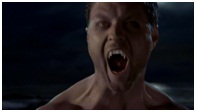 Thus dramatically develops the tension and scares the
audience watching. The music increases and the short length shorten. A second
close-up of one of the boys also shows he has grown fangs, again signifying
vampire, pictured right. A non-diagetic screech is heard and the lengths of the shots are
reduced further as the older male is attacked by all four boys. As the attack
progresses each member, apart from one of the boys who hasn’t attacked the
male, get covered in blood also guts are shown, pictured below. More screams are heard as the
attack progresses adding to the scare.
Thus dramatically develops the tension and scares the
audience watching. The music increases and the short length shorten. A second
close-up of one of the boys also shows he has grown fangs, again signifying
vampire, pictured right. A non-diagetic screech is heard and the lengths of the shots are
reduced further as the older male is attacked by all four boys. As the attack
progresses each member, apart from one of the boys who hasn’t attacked the
male, get covered in blood also guts are shown, pictured below. More screams are heard as the
attack progresses adding to the scare. 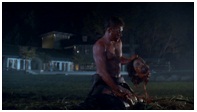 The one boy which hasn’t turned into a
vampire shouts at them to stop but this is to make the audience think the
attack (scare) is over, and decreases the tension, before he says “Make sure
you take the head” thus dramatically increasing the tension in a split second.
Which is then ripped off after being one of the tried to cut it off, whilst the
older male is still alive (pictured left), another false scare is used as one of the boys runs across
the screen to steal it off another, the boy then messes around with it and
kicks it into the sea. Black comedy is used as the boy gets hurt off kicking it
because he kicked the spine. Found footage is used to end the opening scene and
show the dead body on the floor.
The one boy which hasn’t turned into a
vampire shouts at them to stop but this is to make the audience think the
attack (scare) is over, and decreases the tension, before he says “Make sure
you take the head” thus dramatically increasing the tension in a split second.
Which is then ripped off after being one of the tried to cut it off, whilst the
older male is still alive (pictured left), another false scare is used as one of the boys runs across
the screen to steal it off another, the boy then messes around with it and
kicks it into the sea. Black comedy is used as the boy gets hurt off kicking it
because he kicked the spine. Found footage is used to end the opening scene and
show the dead body on the floor.
Opening scene: 3:51
IMDB Page: http://www.imdb.com/title/tt1031254/
Wikipedia Page: http://en.wikipedia.org/wiki/Lost_Boys:_The_Tribe
RM - The Lost Boys Deconstruction
 |
| Theatrical release poster |
Director: Joel Schumacher
Release Date: 1987
Budget: $8.5 million
Takings: $32,222,567 (USA)
Warner Bros. Pictures
 |
| Opening shot of the film |
 |
| Titles screen |
 |
| Establishing shot |
 The shot changes again to a close-up of someone’s feet the
shot pans up however smoke is used to change the mood, although when the
character appears from the smoke the music changes to a stereotypical carnival
theme. These two elements juxtapose each other. The shot has also turned from a
single shot into a group shot.
The shot changes again to a close-up of someone’s feet the
shot pans up however smoke is used to change the mood, although when the
character appears from the smoke the music changes to a stereotypical carnival
theme. These two elements juxtapose each other. The shot has also turned from a
single shot into a group shot. 

 The shot stays the same as the merry go round
goes round but people are having fun by walking around the middle – audience’s
first look at the protagonists of the film or so called “lost boys”? The camera
cuts to one of them, who was the first one the audience sees – signifying the
leader possibly, touching a woman on the cheek, part of a group shot with the
shot containing elements of male and female gaze – the majority of the shot types
and angles have been the same. Thus action causes a re-action, a state of disequilibrium
as a fight breaks out between the boyfriend and the leader of the lost boys.
Shot-reaction-shot between each of the two are used until a guard put his baton
under the neck of the leader – false scare intended? Guard warns the boys not
to be at the carnival, normally used in the build up of a false scare in the
majority of horror movies.
The shot stays the same as the merry go round
goes round but people are having fun by walking around the middle – audience’s
first look at the protagonists of the film or so called “lost boys”? The camera
cuts to one of them, who was the first one the audience sees – signifying the
leader possibly, touching a woman on the cheek, part of a group shot with the
shot containing elements of male and female gaze – the majority of the shot types
and angles have been the same. Thus action causes a re-action, a state of disequilibrium
as a fight breaks out between the boyfriend and the leader of the lost boys.
Shot-reaction-shot between each of the two are used until a guard put his baton
under the neck of the leader – false scare intended? Guard warns the boys not
to be at the carnival, normally used in the build up of a false scare in the
majority of horror movies.  |
| Example of a medium shot |
 |
| Another example of an establishing shot |
 |
| Example of a Point of View (PoV) |
 |
| Another example of a medium shot |
 |
| Last shot in the scene |
 |
| An example of a close-up |
Opening scene 2:55
IMDB page: http://www.imdb.com/title/tt0093437/
Wikipedia page: http://en.wikipedia.org/wiki/The_Lost_Boys
Wednesday, 14 March 2012
RM - Saw Deconstruction
| Theatrical release poster |
Title: Saw
Director: James Wan
Year Released: 2004
Budget: $1,200,000
US Takings: $55,153,403 (USA)
£6,645,485 (UK)
Additional information: There are seven films in the franchise
There is no establishing shot. The first shot
viewed by the audience is a shot of the protagonist underwater. Eerie music is
also played throughout the opening scene which adds tension. The titles of the
film (Saw) appear on screen, effects are used to make it seem the titles are
underwater. This fits in with the opening shot.
The shots used in the opening scene are very
limited, this is due to the location chosen which is a large room, which
features bathroom equipment including a bath and toilet, and although the room
is large shots have been limited in order not to breach the 180-degree rule.
The shots used mainly include close-ups for the protagonist (Adam) and medium
shots used for the secondary character (Lawrence). The times when the two
characters appear on screen (two-shots) is mainly done through the use of long
shots.
The location used, like previously mentioned is a
large room which includes bathroom appliances including a bath and toilet,
however lighting has been used to add to the tension of the film. The lighting
used in the room is dark, this showing that the characters are vulnerable to
the audience. However when the lights are turned on the two characters are dazed
for a couple of seconds, again showing the audience their vulnerability.
Several props feature in the opening scene
including a pistol, a bullet, a cassette player, two cassettes, and two
envelops which have both characters names written on, two saws and two sets of
chains and feet cuffs. Although towards the end of the opening sequence no one
has died it does hint at what is to come. This is anchored when the cassettes
are played as a voice says one of the two characters will have to die in order
for the other one to survive. This is also anchored by a dead body with blood
surrounding him/her on the floor in the middle of the room.
A narrative enigma is also used throughout the
opening scene due to the use of the voice that is speaking in riddles on the
cassette players.
Throughout the opening scene there is always a sense
of panic and tension, this is done through mental torture as when the cassettes
are being played the other character can hear the objective his rival needs to
complete.
At the end of the opening scene the screen turns
green signify a flashback?
IMDB Page: http://www.imdb.com/title/tt0387564/
Wikipedia page: http://en.wikipedia.org/wiki/Saw_(film)
Tuesday, 13 March 2012
RM - Idea 2
After the idents and film’s title appear the audience views
establishing shots of moorland and the surrounding area, a shot could even be
of a small town like Ilkley. The last establishing shot will contain a group of
friends whom are exploring the moor. The group of friends, aged around 18 are
messing around and having laughs. Whilst having messing around the group of
friends enters a local wood, one of the group of friends becomes occupied, i.e.
having to tie his/her shoelace and when he/she looks up they have gone. The
person starts shouting to try and attract his/her friend’s attention but has no
luck. The person then tries to re-trace his/her steps and is met by a hooded figure
the “protagonist” starts to ask the figure questions on the whereabouts of his
friends but the figure just walks forwards with no response, the protagonist
walks backwards into a tree still followed by the figure. A shot changes to of
the outside of the woods and a scream is heard, if possible birds nesting in
the woods would fly up out of the woods after the scream is heard. The scene
then ends.
Sunday, 11 March 2012
RM - Cloverfield Deconstruction
Title: Cloverfield
Director: Matt Reeves
Release Date: 2008
Budget: $25,000,000
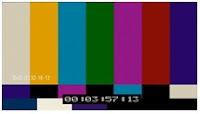 At the start of the idents there
is a loud banging, something approaching, attack or a heartbeat. Stops and hear
crackling noise screen has lines across it for a short time. This is easily
done in final cut express with the use of the effect “Bad TV”. Then the
connections lost sing which beep. Pictured to the left.
At the start of the idents there
is a loud banging, something approaching, attack or a heartbeat. Stops and hear
crackling noise screen has lines across it for a short time. This is easily
done in final cut express with the use of the effect “Bad TV”. Then the
connections lost sing which beep. Pictured to the left.
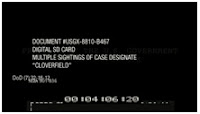
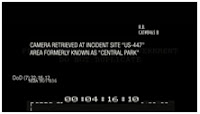 Text appears after the timer
reaches 4 minutes. U.S. Department of defence – signifies something has
happened – flashback to what has happened? Pictured to the left. More text appears – Digital SD
Card – signifies filmed on a handheld camera, furthermore anchored that it was
filmed by a handheld camera with the next piece of text. Pictured to the right.
Text appears after the timer
reaches 4 minutes. U.S. Department of defence – signifies something has
happened – flashback to what has happened? Pictured to the left. More text appears – Digital SD
Card – signifies filmed on a handheld camera, furthermore anchored that it was
filmed by a handheld camera with the next piece of text. Pictured to the right.
At 1:24 into the film first shot
(timer reaches 4:29mins). Time and date of the film are anchored in the bottom
left hand corner. Anchorage that the camera
is handheld – also furthermore by the fact that say the person moves to shakes
from left to right (and vice-versa). Person behind the camera anchors the
location as well as the shot. Shaky camera work adds verisimilitude to the
film.
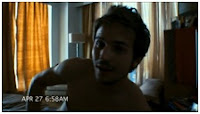
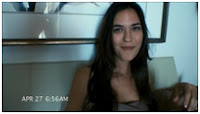 Several jump cuts to
include photographs – family and friends? Another jump cut to a woman in bed –
actions of both people signifies they are in a relationship also the woman is
wearing no clothes further signifies a relationship. Woman says “I can see this ending up on
the internet” signifies something is going to happen? Male is also topless
further anchorage of a relationship between the two. Both male and female gazes play roles in this
scene.
Several jump cuts to
include photographs – family and friends? Another jump cut to a woman in bed –
actions of both people signifies they are in a relationship also the woman is
wearing no clothes further signifies a relationship. Woman says “I can see this ending up on
the internet” signifies something is going to happen? Male is also topless
further anchorage of a relationship between the two. Both male and female gazes play roles in this
scene.
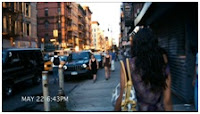 Jump cut to outside,
different date and time anchored in the bottom corner. Currently on a busy street however another jump cut takes the new pair the audience are focusing inside a shop.
Jump cut to outside,
different date and time anchored in the bottom corner. Currently on a busy street however another jump cut takes the new pair the audience are focusing inside a shop.
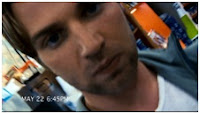
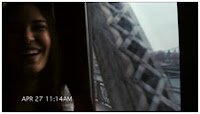
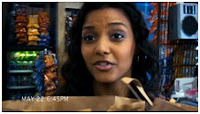 Camera is panned around –
different person is using the camera – jump cut back to an earlier date (27th
April), pictured to the left, and another to take them back to the present (May 22nd), pictured to the right, camera then pans to change the focus on the woman, bottom right.
Another jump cut used to move the time on. Common convention in this film
amongst others, used effectively here, before where in a shop buying items for
a party now in a stairwell – going to the location of the party? Pictured below.
Camera is panned around –
different person is using the camera – jump cut back to an earlier date (27th
April), pictured to the left, and another to take them back to the present (May 22nd), pictured to the right, camera then pans to change the focus on the woman, bottom right.
Another jump cut used to move the time on. Common convention in this film
amongst others, used effectively here, before where in a shop buying items for
a party now in a stairwell – going to the location of the party? Pictured below.
All shots are effectively the same as it’s all been filmed by a handheld prospective although the angles do change, although zoom is sometimes used. To add to that there is no title screen except from the opening text which appears on screen. Thus isn't a common convention amongst films
 |
| Theatrical release poster |
Release Date: 2008
Budget: $25,000,000
Takings: $79,351,605 (USA)
£9,120,932 (UK)
Paramount
Bad Robot
 At the start of the idents there
is a loud banging, something approaching, attack or a heartbeat. Stops and hear
crackling noise screen has lines across it for a short time. This is easily
done in final cut express with the use of the effect “Bad TV”. Then the
connections lost sing which beep. Pictured to the left.
At the start of the idents there
is a loud banging, something approaching, attack or a heartbeat. Stops and hear
crackling noise screen has lines across it for a short time. This is easily
done in final cut express with the use of the effect “Bad TV”. Then the
connections lost sing which beep. Pictured to the left.
 Text appears after the timer
reaches 4 minutes. U.S. Department of defence – signifies something has
happened – flashback to what has happened? Pictured to the left. More text appears – Digital SD
Card – signifies filmed on a handheld camera, furthermore anchored that it was
filmed by a handheld camera with the next piece of text. Pictured to the right.
Text appears after the timer
reaches 4 minutes. U.S. Department of defence – signifies something has
happened – flashback to what has happened? Pictured to the left. More text appears – Digital SD
Card – signifies filmed on a handheld camera, furthermore anchored that it was
filmed by a handheld camera with the next piece of text. Pictured to the right. |
| Opening shot, date and time are anchored in the bottom left. |

 Several jump cuts to
include photographs – family and friends? Another jump cut to a woman in bed –
actions of both people signifies they are in a relationship also the woman is
wearing no clothes further signifies a relationship. Woman says “I can see this ending up on
the internet” signifies something is going to happen? Male is also topless
further anchorage of a relationship between the two. Both male and female gazes play roles in this
scene.
Several jump cuts to
include photographs – family and friends? Another jump cut to a woman in bed –
actions of both people signifies they are in a relationship also the woman is
wearing no clothes further signifies a relationship. Woman says “I can see this ending up on
the internet” signifies something is going to happen? Male is also topless
further anchorage of a relationship between the two. Both male and female gazes play roles in this
scene. Jump cut to outside,
different date and time anchored in the bottom corner. Currently on a busy street however another jump cut takes the new pair the audience are focusing inside a shop.
Jump cut to outside,
different date and time anchored in the bottom corner. Currently on a busy street however another jump cut takes the new pair the audience are focusing inside a shop.

 Camera is panned around –
different person is using the camera – jump cut back to an earlier date (27th
April), pictured to the left, and another to take them back to the present (May 22nd), pictured to the right, camera then pans to change the focus on the woman, bottom right.
Another jump cut used to move the time on. Common convention in this film
amongst others, used effectively here, before where in a shop buying items for
a party now in a stairwell – going to the location of the party? Pictured below.
Camera is panned around –
different person is using the camera – jump cut back to an earlier date (27th
April), pictured to the left, and another to take them back to the present (May 22nd), pictured to the right, camera then pans to change the focus on the woman, bottom right.
Another jump cut used to move the time on. Common convention in this film
amongst others, used effectively here, before where in a shop buying items for
a party now in a stairwell – going to the location of the party? Pictured below.All shots are effectively the same as it’s all been filmed by a handheld prospective although the angles do change, although zoom is sometimes used. To add to that there is no title screen except from the opening text which appears on screen. Thus isn't a common convention amongst films
Opening scene 4:50.
IMDB page: http://www.imdb.com/title/tt1060277/
Wikipedia page: http://en.wikipedia.org/wiki/Cloverfield
IMDB page: http://www.imdb.com/title/tt1060277/
Wikipedia page: http://en.wikipedia.org/wiki/Cloverfield
Subscribe to:
Comments (Atom)










